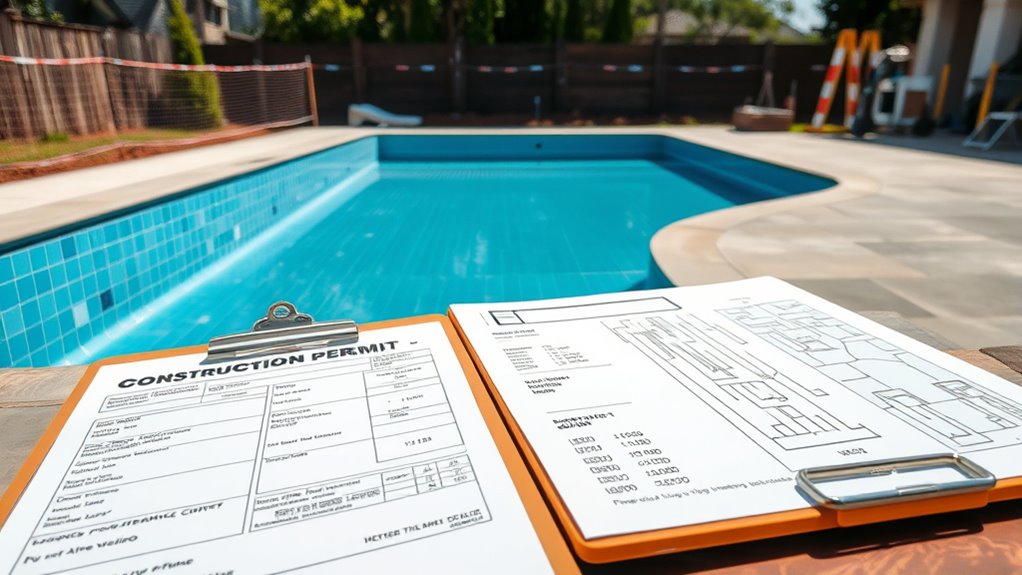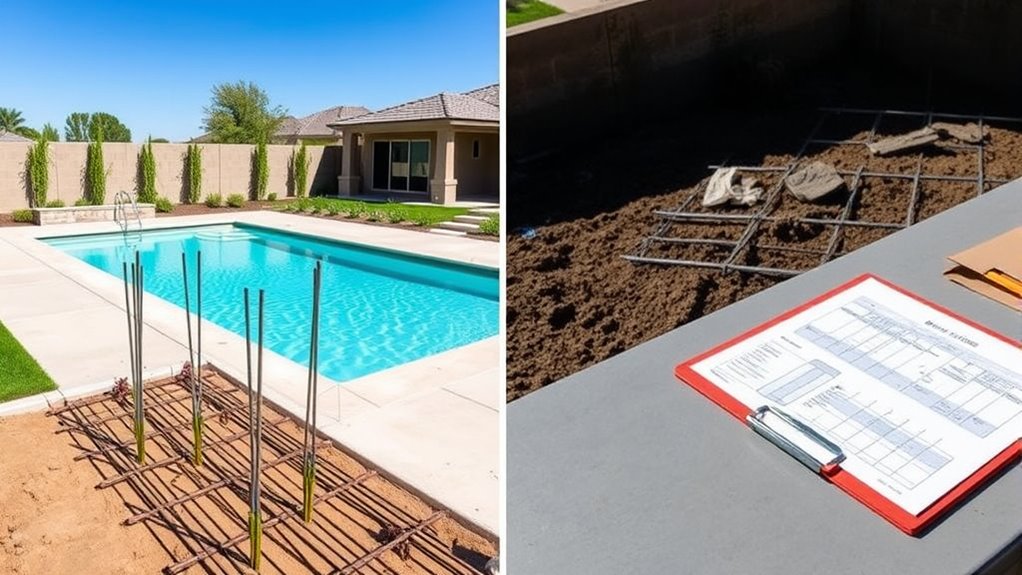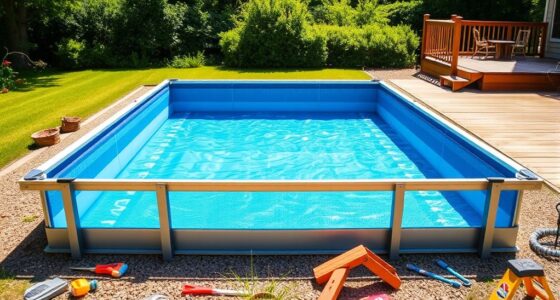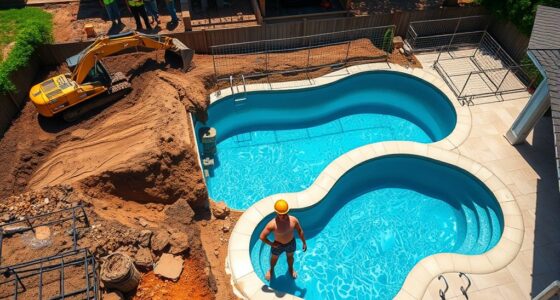Before building a pool, it’s essential to obtain the necessary permits and understand local regulations to avoid delays, fines, and safety issues. You’ll need to research building codes, safety standards, and environmental rules, such as fence height, depth markers, and runoff management. Working with professionals can help guarantee your plans meet all requirements. If you want to stay compliant and protect your investment, there’s more detailed information you should explore.
Key Takeaways
- Obtain necessary permits before construction to ensure compliance with local building codes and avoid fines or delays.
- Follow safety standards like fence height, locking gates, and depth markers to protect users and meet legal requirements.
- Prepare detailed plans demonstrating safety and environmental compliance, often with professional assistance, for permit approval.
- Consider environmental impacts such as water runoff, wildlife, and ecosystems; implement eco-friendly features when possible.
- Complying with permits and regulations ensures safe, legal, and environmentally responsible pool construction, saving time and reducing risks.

Understanding permits and regulations is vital before starting any project or activity. When it comes to building a pool, skipping this step can lead to costly delays, fines, or even having to tear down your work. Local authorities typically have specific rules to guarantee that your project aligns with safety standards and environmental considerations. One key aspect you’ll need to focus on is pool safety. Regulations often dictate how high fences must be, the type of locking gates required, and the depth markers needed to prevent accidents, especially if children will be around. These rules aren’t just bureaucratic hurdles—they’re designed to protect you, your family, and visitors from preventable mishaps. Failing to comply can result in legal consequences and increased liability if someone gets hurt. To avoid these issues, start by researching your city or county’s building codes and pool regulations. Many jurisdictions require permits before you begin construction, and obtaining one usually involves submitting detailed plans that demonstrate your adherence to safety standards.
Beyond safety, environmental impact is a vital consideration embedded in permits and regulations. Building a pool isn’t just about excavation and concrete; it can also affect local water quality, drainage, and ecosystems. Regulations often specify how you manage runoff to prevent chemicals, debris, or excess water from polluting nearby streams or groundwater. Some areas may require you to include eco-friendly features like solar covers or energy-efficient pumps, which reduce your environmental footprint. You might also need to assess how your pool’s construction and operation impact local wildlife or vegetation. Failing to consider environmental impact can lead to legal penalties or the forced removal of your pool. By understanding these requirements upfront, you can plan your project to minimize adverse effects, such as designing proper drainage systems and using sustainable materials.
Getting the necessary permits is a straightforward process if you understand the regulations involved. Usually, you’ll need to submit detailed plans, possibly including site surveys, safety features, and environmental protection measures. Working with professionals like architects or contractors familiar with local rules can streamline this process. Remember, permits are not just about legality—they’re also about ensuring your pool is safe and environmentally responsible. Ignoring these regulations can jeopardize your project and compromise safety standards, which is why thorough research and compliance are vital from the start. Taking the time to understand permit requirements will save you headaches later and help you enjoy your new pool with peace of mind, knowing that you’ve built it responsibly and legally.
Frequently Asked Questions
Are There Specific Rules for Above-Ground vs. In-Ground Pools?
You should know that above-ground and in-ground pools have different rules for pool safety and fencing requirements. Above-ground pools often need a barrier or fencing to prevent accidents, but the height and design might differ. In-ground pools typically require stricter fencing and safety measures, especially around the perimeter. Always check local codes to confirm your pool meets safety standards, keeping everyone safe and compliant.
How Long Does the Permit Approval Process Typically Take?
Did you know that most permit approvals take around 2 to 4 weeks? The permit timeline varies depending on your location and project complexity. During this approval duration, authorities review your plans to guarantee safety and compliance. It’s vital to initiate the process early, as delays can happen if paperwork is incomplete. Planning ahead helps avoid costly setbacks, so check with your local building department for specific timelines in your area.
What Are the Common Fines for Building Without Permits?
Building without permits can lead to hefty fines. The fines overview varies by location but often includes daily penalties and significant one-time fees for permit violations. You might also face orders to demolish or modify your pool if it was built illegally. These fines aim to enforce safety standards and regulations, so always secure the necessary permits beforehand to avoid costly penalties and legal issues.
Do Regulations Vary Between Residential and Commercial Pools?
Think of regulations as the blueprint guiding your pool project. Yes, they do vary between residential and commercial pools. You need to navigate different zoning restrictions and safety standards depending on your pool’s purpose. Commercial pools often face stricter rules to protect public safety, while residential pools focus on property-specific regulations. Understanding these differences helps guarantee your project complies fully, avoiding fines or delays down the line.
Are There Environmental Restrictions Affecting Pool Construction?
You should consider environmental restrictions that affect pool construction because they focus on reducing environmental impact and supporting local conservation efforts. Local laws may limit water usage, prohibit certain materials, or restrict construction near protected areas. By understanding these restrictions, you can plan responsibly, minimize your pool’s environmental footprint, and ensure compliance with conservation goals. Always check with local authorities to stay informed about specific environmental regulations in your area.
Conclusion
Before diving into your pool project, make sure you’ve got all the permits and regulations sorted out. It’s better to cross your T’s and dot your I’s now than face hurdles later. Think of it as laying a solid foundation for a house; without it, everything could come crashing down. Staying informed and compliant guarantees your backyard oasis becomes a smooth swim, not a sinking ship. So, take the time now—your future self will thank you.









